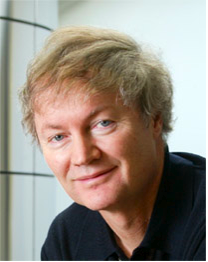Professor Michael Grätzel from Switzerland is the winner of the 2010 Millennium Technology Prize for his third generation, low cost, dye-sensitized solar cells. Tarja Halonen, the President of Finland, presented the 800,000 Euro Grand Prize and the prize trophy “Peak” to Professor Grätzel on June 9 at the Grand Award Ceremony at the Finnish National Opera, Helsinki.
“One of mankind’s greatest challenges is to find ways to replace the diminishing fossil fuel supply. The most obvious energy source is the sun, origin of most energy found on Earth. The Winner of the 2010 Millennium Technology Prize, Professor Michael Grätzel, Director of the Laboratory of Photonics and Interfaces at Ecole Polytechnique Fédérale de Lausanne (EPFL), has responded to the challenge with his dye-sensitized solar cells”…”The constraint of solar energy has traditionally been its price. ‘Grätzel cells’ provide a more affordable way of harnessing solar energy. Grätzel’s innovation is likely to have an important role in low-cost, large-scale solutions for renewable energy,” says the President and CEO of Technology Academy Finland, Dr Ainomaija Haarla, explaining why Grätzel was selected as the winner (source).
Grätzel says windows could be made into solar panels. You would be able to see through them, but they may have a slight tint because of the solar cells: “You could think that the glass of all high-rises in New York would be electricity-generating panels,” he told BBC News. As solar cells become cheaper to produce, they’ll also start showing up in other places, too, ‘Grätzel says in a YouTube video about his inventions. “What we see more and more will be that solar cells will become integrated in the living space,” he says in the video. Solar cells “could be a piece of furniture. They could be the keyboards … It could be put in as a lamp on the street — autonomous lamps that have no power supply.”
“The decision was made by the Board of Directors of Technology Academy Finland, based on the recommendation of the International Selection Committee. The price/performance ratio of Grätzel’s dye-sensitized solar cells is excellent. The technology, often described as ‘artificial photosynthesis,’ is a promising alternative to standard silicon photovoltaics. It is made of low-cost materials and does not need an elaborate apparatus to manufacture. Though Grätzel cells are still in relatively early stages of development, they show great promise as an inexpensive alternative to costly silicon solar cells and as an attractive candidate as a new renewable energy source. Grätzel cells, which promise electricity-generating windows and low-cost solar panels, have just made their debut in consumer products” (Ibid.).
According to its web site, The Millennium Technology Prize is Finland’s tribute to life-enhancing technological innovations. The prize has been established to steer the course of technological development to a more humane direction. In particular, the prize seeks to highlight innovations that assist and enrich our everyday lives today as well as in the future. The prize is awarded every second year. “The Millennium Technology Prize is the world’s biggest technology prize and it is awarded by the Technology Academy Finland, an independent fund established by Finnish industry and the Finnish state in partnership. The aims of the prize are to promote technological research and innovation that have a positive impact on the quality of life, alleviate fears towards technological change and encourage discussion between technology specialists and societal decision makers” (Ibid.). Previous winners of the prize have included Sir Tim Berners-Lee, who is widely credited as having invented the web, and UCSB Professor Shuji Nakamura, who invented blue and white Light Emitting Diodes.





